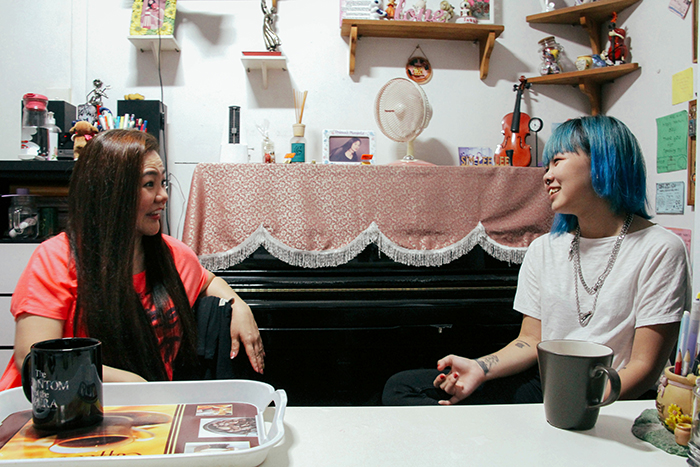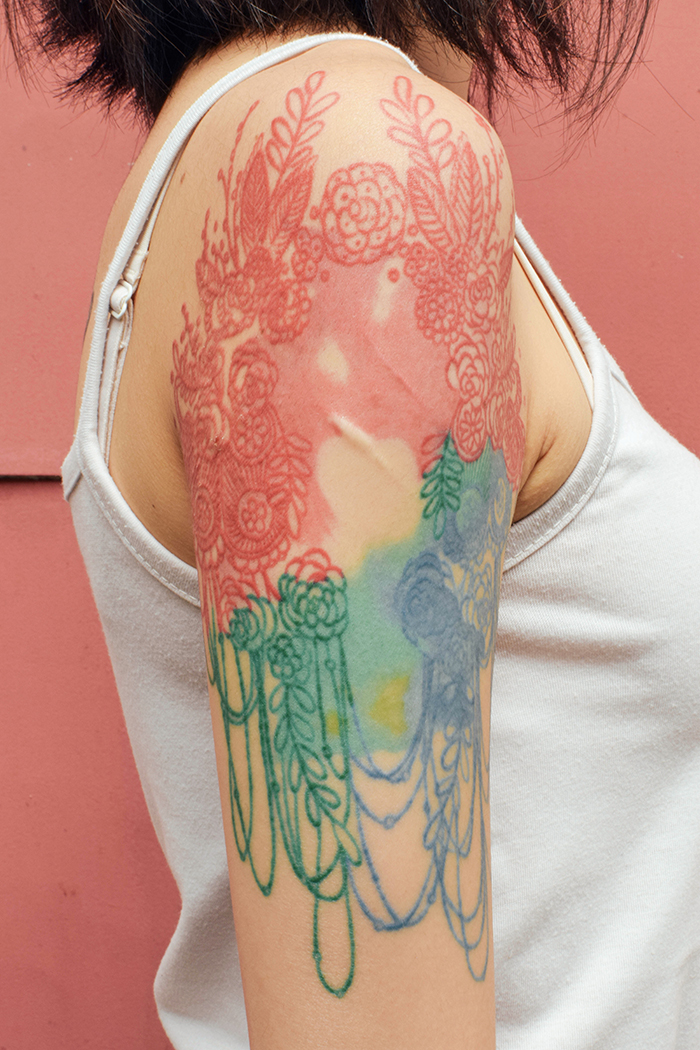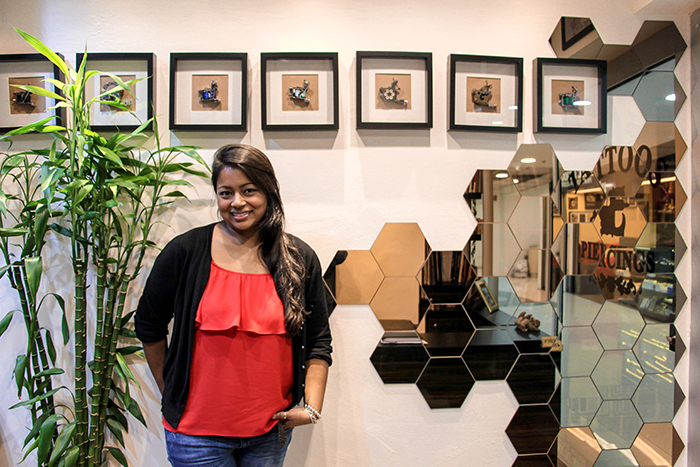hen she was 18, Clare Chong received a love letter from an ex. It held the question “do you want to get back together?”, along with smears of his blood. Creative, morbid soul that she is, Clare decided to reply blood with blood – or ink, so she had the answer tattooed on her knee. When she presented her freshly bandaged wound to her lover to unwrap, he got his answer – a raw, black “yes” stencilled into her skin.
Five months later, they called it quits. Cue the “I told you so”s and smug head shakes, but the feisty LASALLE film student, now 20, doesn’t mind that she has a reminder of the relationship which she can never erase.
“I’m very impulsive about most of my tattoos, so I just do whatever I want, and even if it’s bad at least I know that that’s an emotional decision I made,” she said. “So I don’t really regret my tattoos, nor do I have very strong emotions towards them.”

Visual diary: Clare says she's thankful her mother Sim Lee Lee, 50, is accepting of her tattoos – and so takes the opportunity to add to her growing collection.
"I think it’s fun to see my preferences and what I like and dislike grow over time. One day I’m going to hate the tattoos that I have now. But I imagine it would be nice to look back at a time where I liked those tattoos or I liked this specific style."
For Clare, the personal story that comes with a tattoo is secondary. What matters is embracing every part of her person – even the lovesick fool who tattooed in the heat of the moment two years ago.
“Actually it looks like ‘sex’ when you turn it over,” she laughed.
Call her flippant, but Clare represents the growing number of youths taking worries about permanent body ink with a pinch of salt. Whether it’s because they’re more confident in their decisions, or the simple fact that they embrace everything they put on their skin, millennials are confident that they’re less susceptible to one day regretting their tattoos.
Hitting a new peak
The subsiding feelings of regret come amid an all-time high for the tattoo scene. The practice of putting needle to skin may no longer be fresh and exciting, but getting inked is more popular now than ever. In the United States, 45 million people have at least one tattoo. Nearly four in ten American millennials have a tattoo, and of that group 69 per cent has more than one.
In Singapore, that fire is catching – a fact local artists attest to by the sheer number of new tattoo establishments popping up around the island every day.
According to tattoo artist Sumithra Debi, 36, the industry has grown from a humble 20 or 30 parlours in the 90s to hundreds today – more, even, thanks to home artists who run their business from the comfort of rent-free houses.
“We could name you the specific few parlours,” says Debi, who is the island’s first female tattoo artist, and the owner of ExoticTattoos in Far East Plaza.While many are quick to recall Far East Plaza as the original hub of tattooing in the 00’s, industry veterans beg to differ. Debi names three iconic places where the tattoo scene concentrated in the past.
The first, Peninsula Shopping Centre, dominated by a pioneer batch known in the industry as the “Peninsula artists”.
The second, Transit Road at Nee Soon Camp – now demolished, though it once flourished from the patronage of “army boys” in its heyday.
And lastly, Bras Basah Road, where the original Johnny Two Thumbs shop first started, before its grand move to Far East Plaza – where the scene eventually picked up. Now, she’s lost track of the new hands who’ve joined the industry.
With more new artists around, customers no longer have only Far East Plaza to turn to. Smaller studios are sprinkled in all corners of the island, but tattoo enthusiasts name the area from Chinatown to Bugis as the new it-place to get inked.
Tattoo artists interviewed also noted a change in who walks through their doors. While the traditional stream of heavily tattooed men coming in hasn’t slowed, parlours are seeing newer faces as well – more teachers, young office workers, and certainly more women, all agree.
Bradley Tan, 29, owns the studio Oracle Tattoo on Jasmine Road, and estimates the age of his clientele to span mid 20s to late 50s. The studio receives five or six customers a day, while Debi sets her average around eight.
“A lot more people are coming in and becoming more open to getting bigger pieces,” said Tan, who started tattooing in 2003. “Back in the day most of the pieces were constrained within where could be covered by clothes. Now people are a bit more ‘lax’ with the idea.”
“You see younger ladies having full sleeve tattoos,” Debi agreed.
Covering Up
As more virgin-skinned youth make their maiden trips to tattoo parlours, the possibility of one day regretting their decision and having to remove it is growing further from their thoughts.
The common reason for their new bravado? Simply that if they ever do regret a tattoo, they can just cover it up with another one.
When 19-year-old Benedict Choo realised he hated his first tattoo, a lopsided smiley face on his ankle inked as a favour from a very drunk friend, he had it covered up with a small black triangle.

Technicolour: Lee Jing Yi's one-of-a-kind colour tattoo has evolved in tandem with changing events in her life.
But why not just laser it off?
“That was part of my life so I don’t mind,” explained the Singapore Polytechnic student, who’s since gotten three more tattoos, and is midway through inking a three quarter sleeve of on-trend geometry and dot work.
A sleeve will be much harder to just layer over next time, but Benedict is adamant he will never resort to removing a tattoo. “It would just be more ink,” he added nonchalantly.
It’s a plan that resonates with many. When Lee Jing Yi got a watercolour tattoo in the shape of Germany on her right shoulder four years ago, it was to represent a personal love philosophy inspired by a song titled “German Love”. Today, the meaning has lost its relevance but not its place on the 23-year-old’s petite frame.
The tattoo reminded her of a period of her life she wanted to commemorate, so she did not want to erase that from her life, she explained. Instead, she added green, pink and blue floral motifs to her existing piece, to symbolise blooming, and growing out of those ideals.
“I wouldn’t regret anything that I put on my body, whether or not it’s something I still believe in,” she said.
“I think whether or not you agree with your past self, that self made the decisions that have led to this point in time, so why try to erase it?”
It all adds up
And therein lies the issue – removing a tattoo is akin to rejecting that part of your life, which millennials find more fault with than an embarrassing tattoo. Rather than dwell on regret, youths would rather embrace the bad and move on; because it’s all in the past anyway.
Social media culture makes us feel like if we’re not up-to-date then we’re behind.
Prof Samuel Han
According to experts, this focus on the now has social media to thank.
Sociologist Samuel Han, 33, attributed it to the idea of backward chronology, which platforms like Facebook and Instagram function on. There, user profiles are structured to display timelines that always promote the newest posts – and that emphasis has started to infiltrate human thinking.
“Technology allows for the acknowledgement of new and seemingly better things,” the sociology professor at Nanyang Technological University said. “So appearance culture has turned into something like an anxiety – am I up-to-date? Am I keeping up?”
And whether it’s ink or a status update, looking forward is the way to go. The universal timeline, Professor Han says, parallels how many social media users view themselves today.
“It structures us into thinking the now is most important and what was before, whatever; we just need to scroll up. And that kind of culture is going to make us feel like if we’re not up-to-date then we’re behind.”
Which might explain tattooed individuals’ compulsion to keep adding more. Clare, who recently had her tenth piece done along her left ribs, doesn’t see herself quitting the ink any time soon.
“Even when you’re fully covered you might still want to put tattoos over your tattoos,” she said. “You can’t ever say you’re done; I don’t think you can.”
Cause for concern
But while more youths are feeling more confident about their decisions, others are still sceptical. And more often than not, the loudest voices arguing against a tattoo come from home.
Before he got his first tattoo, Benedict used to battle his parents to get their permission. “They kept saying no; their biggest concern was what if you regret it?” he said.
Clare has had a little more luck with her mother, Sim Lee Lee, but the 50-year-old piano teacher considers herself an exception to the rule.
“Now it’s like fashion, but the older generation has a bad impression of tattoos – because of gangsters,” she said. “It’s like, if you are not gangster, you won’t put a tattoo, right?”
Her concerns are not unfounded, given Singapore’s prominent history of tattoos and gang culture. Between the 50s and the 70s, gang members were marked by ink to show their membership and loyalty to a gang. Then, the mainstays of tattoo art were limited to traditional Japanese styles, influenced directly by the yakuza.
Debi, who first stepped onto the scene at 15, admits the stigma surrounding tattoos has everything to do with the fact that in the past its main wearers were often on the wrong side of the law.
“There were still a lot of gangs around when I first came into the scene – a lot of the ah bengs; you had the Yishun gangs, the Salakau (Hokkien for 369, a local street gang), the Omega gang,” she says.
“The stigma naturally comes from the fact that it’s always gang-related.”
And unfortunately, the negative association is something many are still finding hard to shake – particularly the implications a tattoo might have in the workplace.
A study conducted by Skinfo.com in the US found that 37 per cent of human resource managers named tattoos as the third most likely physical attribute to limit career potential – behind bad breath and facial piercings.
Tattoos on the face and neck, not surprisingly, carry the most stigma even today, which is why many artists refuse to entertain such requests from customers who aren’t already at least 80 per cent covered. In fact, their reason ties back to the mindset that a bad tattoo can always be covered up.
“It’s an ethical problem for a lot of tattoo artists, because if you tattoo on the neck you cannot cover that anymore,” said Bernice Chua, 27, an apprentice at TattooWorld on North Bridge Road.
“We want to make sure you’re thinking this through and we don’t want to ruin your life, because if you can’t find a job next time it’s on us.”
Tan has a less sombre outlook on face and neck tattoos, but even so, he cautions against the heavy commitment.
“Even for myself, in this industry; I’d take some time to think about that,” he said. “It’s just the kind of looks that you get – is someone who’s not in our trade ready for that?”

Odd one out: Sumithra Debi, 36, stands with her collection of tattoo machines. Over 20 years she’s collected 30 odd machines.
Because she’s “fickle-minded”, Debi has no tattoos herself – which doesn't sit well at tattoo conventions, where heavily tattooed artists question her legitimacy as an artist.
To properly understand feeling the pain of a tattoo, she’s put the tattoo needle to her own skin – without the ink, and scarred for 6 to 8 months after.
“If you don’t feel the pain, then how would you know when you’re inflicting it on somebody else?” she said. “You care for the client, and in order to do that you have to know how it feels.”
Born ready
While the desire for a neck tattoo remains relatively rare, more youths feel ready to take the concern about employment in their stride.
Whether they work in the creative industries or traditionally conservative, “professional” jobs, such as careers in education and finance, millennials are finding ways to take control of their situation.
Arjun Asothan, 23, is studying law at Monash University, but that hasn’t stopped him from collecting his four tattoos. His solution is simply to ink in places he can conceal with clothing – not as a sign of surrender, but as an acknowledgement that “there’s definitely still stigma”.
“I’ve still got to look at my profession. I’m going to be a lawyer and can’t go into court with that,” he said. “I’ll lose the case straightaway.”
Still, dressing to conceal isn’t limited to the professional careers. Even youth working in the media, where body ink and other forms of aesthetic expression like piercings and hair dye are less frowned upon, can be cautious. Jing Yi, a features writer at a local magazine, says she’s thankful the environment she’s in doesn’t judge her, but still covers up occasionally out of respect.
She has a tattoo on her finger, though, that she has left unwrapped in countless job interviews in the past. “They’re going to find out eventually, and if that bothers them already, then I’m not going to be able to fit in that company culture,” she said.
As for Clare, a little ink, visible or not, is no issue at all. If anything, she takes her cue from the older figures in the film industry, who, according to her, are covered in tattoos.
“It doesn’t matter; how you look does not define what you do in the film industry,” she said. “No one cares. They care about your experience, which is a big relief.”